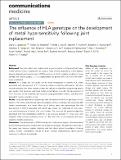The influence of HLA genotype on the development of metal hypersensitivity following joint replacement
Abstract
Background Over five million joint replacements are performed across the world each year. Cobalt chrome (CoCr) components are used in most of these procedures. Some patients develop delayed type hypersensitivity (DTH) responses to CoCr implants, resulting in tissue damage and revision surgery. DTH is unpredictable and genetic links have yet to be definitively established. Methods At a single site, we carried out an initial investigation to identify HLA alleles associated with development of DTH following metal-on-metal hip arthroplasty. We then recruited patients from other centres to train and validate an algorithm incorporating patient age, gender, HLA genotype44 and blood metal concentrations to predict the development of DTH. Accuracy of the modelling was assessed using performance metrics including time dependent receiver operator curves. Results Using next generation sequencing, here we determine the HLA genotypes of 606 patients. 176 of these patients had experienced failure of their prostheses; the remaining 430 remain asymptomatic at a mean follow up of twelve years. We demonstrate that the development of DTH is associated with patient age, gender, the magnitude of metal exposure and the presence of certain HLA class II alleles. We show that the predictive algorithm developed from this investigation performs to an accuracy suitable for clinical use, with weighted mean survival probability errors of 1.8% and 3.1%53 for pre-operative and post-operative models respectively. Conclusions The development of DTH following joint replacement appears to be determined by the interaction between implant wear and a patient’s genotype. The algorithm described in this paper may improve implant selection and help direct patient surveillance following surgery. Further consideration should be given towards understanding patient specific responses to different biomaterials.
Citation
Langton , D J , Bhalekar , R M , Joyce , T J , Rushton , S P , Wainwright , B J , Nargol , M E , Shyam , N , Lie , B , Pabbruwe , M , Stewart , A J , Waller , S , Natu , S , Ren , R , Hornick , R , Darlay , R , Su , E P & Nargol , A V F 2022 , ' The influence of HLA genotype on the development of metal hypersensitivity following joint replacement ' , Communications Medicine , vol. 2 , 73 . https://doi.org/10.1038/s43856-022-00137-0
Publication
Communications Medicine
Status
Peer reviewed
ISSN
2730-664XType
Journal article
Description
We thank Innovate UK Edge for providing funding to allow this research to be carried out.Collections
Items in the St Andrews Research Repository are protected by copyright, with all rights reserved, unless otherwise indicated.

